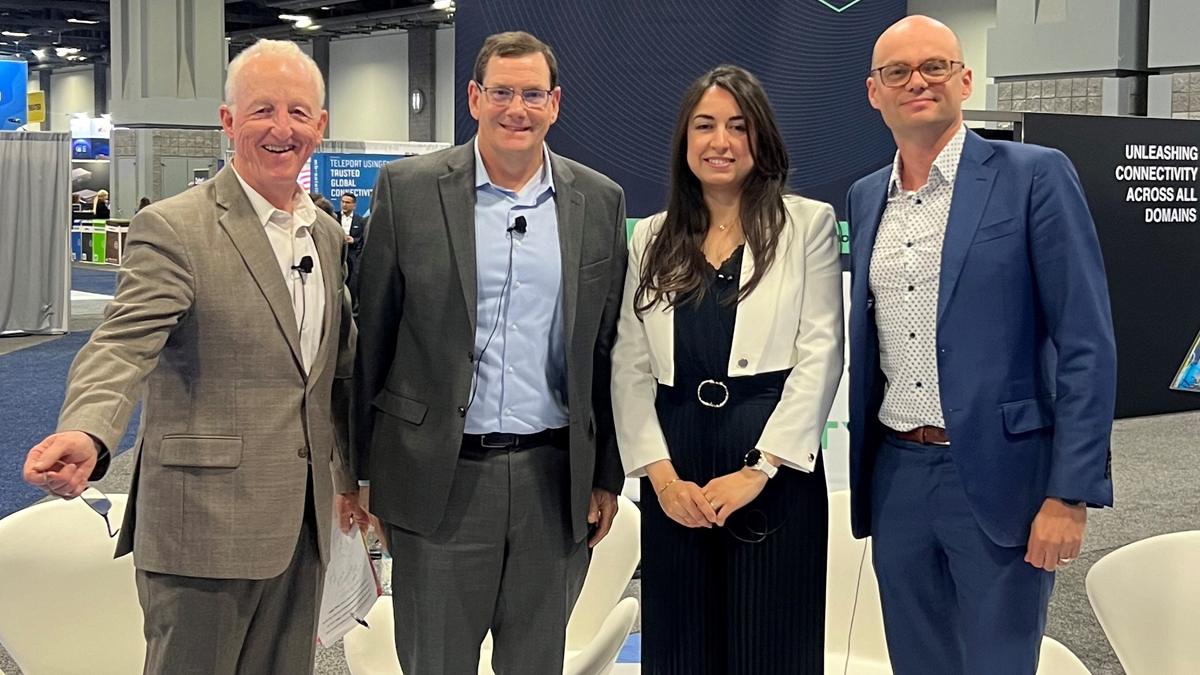 From left to right, Constellations host John Gilroy with Stuart Daughtridge of Kratos, Amina Boubendir with Airbus Defence and Space and Nathan de Ruiter of Novaspace at the Satellite 2024 conference in Washington, D.C. (Source: Kratos)
From left to right, Constellations host John Gilroy with Stuart Daughtridge of Kratos, Amina Boubendir with Airbus Defence and Space and Nathan de Ruiter of Novaspace at the Satellite 2024 conference in Washington, D.C. (Source: Kratos)
ALEXANDRIA, Va. — Constellations recorded live at Satellite 2024 with guests Nathan de Ruiter of Novaspace, Amina Boubendir of Airbus Defence and Space and Stuart Daughtridge from Kratos. The three experts discussed the capabilities of software-defined ground systems and the variety of relevant applications within the satellite industry.
A Software-Defined Industry
Novaspace, a merger of Euroconsult Group and SpaceTec Partners, recently released a report that shows “a clear shift” toward software-defined satellites. “If you look at satellite orders from 2019, more than 50% of those GEO and HTS satellites … are fully software-defined,” said de Ruiter, Partner and Managing Director at Novaspace. By 2023, the number of HTS orders grew to 60%.
Satellite operators are interested and invested in moving toward software and digitization as a solution for flexibility and overall increased capabilities. “It’s something that is needed for this industry to move forward and remain competitive,” said de Ruiter.
The other panel members agreed with this assessment, noting the importance of staying on the cutting edge of technology. “If the rest of the industry is going to compete with Starlink, they’re going to have to grow the amount of capacity they have per satellite,” said Daughtridge, Vice President of Advanced Technology at Kratos and Chairman of the DIFI Consortium.
Growing capacity means growing capabilities in every stage of satellite management, including the ground. “There is a strong value in software-defined solutions,” de Ruiter said, “but it requires investment on the satellite, and on the ground.”
According to Daughtridge, nobody within the industry will be able to remain truly competitive without good ground support. Satellite operators will need “to have cost-effective ground infrastructure to be able to implement [software definition],” he said.
Ground as More than an Afterthought
To make the most of a software-defined satellite, ground infrastructure will need to be treated as more than an afterthought. Software-defined satellites are less bespoke than traditional satellites and are often described as “cookie cutter” in design. As a result, “the difference between satellite operators can now become more about orbital slots and about their ground infrastructure and their ground systems,” said Daughtridge, instead of about distinct hardware designs.
Ground systems will also be driven increasingly toward software, especially due to price differences. “With the first ultra-wideband satellites, the ground systems with the legacy architectures actually started costing more than the satellite because they were very hardware-centric,” said Daughtridge. “And that’s a problem for the industry.” Software-defined ground, on the other hand, “gives you a different cost structure to go after building the ground system at scale, as is needed for these software-defined satellites.”
Generic purpose computing hardware, both on the ground and in orbit, allows the entire satellite system to be more dynamic. “Software is a disaggregation of the networks,” said Boubendir, Head of Research and Standardisation at Airbus Defence and Space. “We cannot remain with the old systems that were built for vertically integrated solutions.”
Industry organizations, like the DIFI Consortium, are working with generic hardware systems that will open up software opportunities for customers and make the entire system more flexible and dynamic. “We’re working on making the antenna, and the ground system, the simplest possible so that all the processes, all the network functions can go into generic purpose hardware,” said Boubendir. “And that’s where the cloud comes into play.”
A Multitude of Applications
Integrating software can improve nearly any satellite system, including commercial satcom, military satcom and Earth observation. “Where we see the best fit is basically, primarily, the applications where demand can really evolve, or the demand patterns can really change,” said de Ruiter. This includes markets such as mobility, airlines, or geopolitical conflict—all areas where it can be hard to predict bandwidth and communications demands over the long term.
The flexibility of software allows providers to offer a variety of different services while relying on a service-based business model. Ultimately, the traditional model of selling dedicated raw capacity is changing, Boubendir said, and satellite network operators can now “rethink their business models, because instead of dedicating the capacity to a certain client, they can still reuse the same assets and share it as needed between different clients.”
Softwarization will inform every aspect of the satellite industry. “The way I see the future looking is these software-defined satellites are basically going to start to look like network switches or routers in the sky,” said Daughtridge. “You’re going to start managing your network the same way the terrestrial guys do. And so satellite ground systems will start looking like ORAN [Open Radio Access Network].”
To hear more about industry standards, terrestrial integration and standardized solutions, listen to the full podcast recording here.
